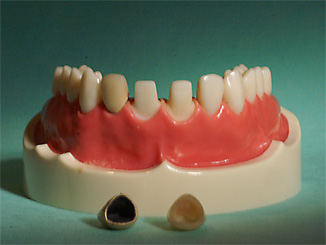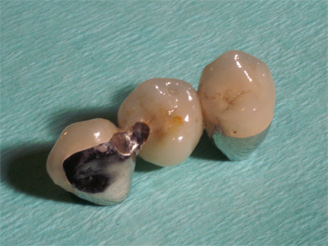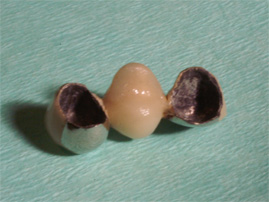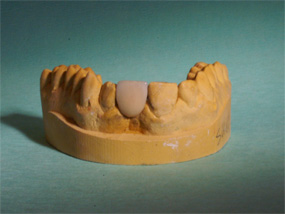Crowns, Bridges & Implants
Crowns
Restoring badly damaged teeth or replacing missing teeth is the job of advanced dental techniques such as crowns, bridges and implants. Crowns are ‘jackets’ of metal, porcelain or a mixture of both that are designed to sit onto an adequately prepared tooth to restore function and/or aesthetics as appropriate. Teeth are prepared by being cut into smaller sizes, and a crown is manufactured at a laboratory on a model that is prepared from an impression of the prepared tooth. Being stronger than the original tooth and because it sits over the surface of the tooth, the crown gives added support th the tooth structure which would have been weakened through fracture or extensive filling.
Bridges
Bridges are two or more crowns joined together that replace a missing tooth. A tooth adjacent to a space is crowned, with a second crown joined onto it which replaces the missing tooth. A special sort of bridge known as an adhesive bridge does not make use of the first crown, rather it uses a metal wing that sticks to the adjacent tooth using a special cement, and serves the same function as a traditional bridge. Adhesive bridges have the advantage that they are reversible, and one does not have to cut an adjacent tooth to take a crown.
-

Crowns
This model shows teeth prepared for crown placement. One crown has a metal sub-structure whereas the other one is more aesthetic and is made entirely out of porcelain
-

Bridges
A traditional 3-unit bridge, with a crown on either end welded to a replacement tooth in the middle
-

Bridges
The same bridge showing the fitting surface
-

Maryland Bridges
An adhesive bridge showing the 2 supporting 'wings'
-

Maryland Bridges
The bridge 'in situ' filling in the space in the aesthetic zone
Disadvantages of Crowns & Bridges
Both crowns and conventional (non-adhesive) bridges involve cutting a tooth down to a certain extent, to allow room for the supporting crown to be cemented. This implies a risk of possible damage to the said tooth – around 40% of crowned/bridged teeth will develop inflammation (pulpitis) which may manifest as sensitivity or discomfort for a while following cementation of the crown/bridge. In most cases, this sensitivity will eventually resolve, but in some cases, the pulpitis becomes irreversible, and might lead to toothache in the long-term, with the affected tooth/teeth requiring extraction or Root Canal Treatment.
Implants
Implants are the ultimate in replacing missing single or multiple teeth. Metal or crystalline implants resemble screws, which are placed in a precise manner into the bone under the gums. Following a discrestionary period of healing to allow integration of the implants into the bone, the implants are then restored the conventional way with a crown or a bridge on the surface. In cases of fully edentulous patients, a number of implants (typically 3 or 4 top and bottom), are used to support a fixed bridge (usually screwed into place) or a removable denture, that is more likely to stay securely in place being aided by special connectors.
Since no other adjacent teeth are harmed or relied on in replacing a tooth or a number of teeth when implants are used, these are quickly becoming the method of choice for replacing missing teeth, especially in aesthetically-conscious patients and in difficult cases where other options might not be beneficial in the long term. The only drawback at the moment is cost, since implants may cost around £2,000 for initial placement
